Design and Shape Monitoring of a Morphing Wing Trailing Edge
Abstract
1. Introduction
2. Variable Camber Trailing Edge
2.1. Mechanical Solution
2.2. Optimization of Morphing Rib
2.3. Design of the Prototype
3. Shape Monitoring Method
3.1. Sensor System Based on FBG Sensors
3.2. Monitoring Algorithm
4. Experiments and Discussion
4.1. Prototype and Demonstration Platform of VCTE
4.2. Functionality Test
4.3. Shape Monitoring Experiment
5. Conclusions
- According to the target deflections of the reference airfoil, the proposed parametric optimization design method of the multi-segment morphing rib can provide a solution for VCTE structure which can effectively realize smooth and continuous deformation.
- The functionality test indicated that the VCTE prototype could achieve a maximum deflection range from 5° upward to 15° downward, which satisfied the design requirements.
- An indirect shape monitoring method-based FBG sensor beam was proposed and the real-time deflection angles of the VCTE were evaluated by using the measured strain values and the KO algorithm.
- The shape monitoring method was experimentally verified via comparison with measured deflections using optical equipment. The maximum relative error was less than 4.03%, showing good agreement at each deformed state.
Author Contributions
Funding
Institutional Review Board Statement
Informed Consent Statement
Data Availability Statement
Conflicts of Interest
References
- Ameduri, S.; Concilio, A. Morphing Wings Review: Aims, Challenges, and Current Open Issues of a Technology. Proc. Inst. Mech. Eng. Part C J. Mech. Eng. Sci. 2020, 0, 095440622094442. [Google Scholar] [CrossRef]
- Concilio, A.; Dimino, I.; Pecora, R. SARISTU: Adaptive Trailing Edge Device (ATED) Design Process Review. Chin. J. Aeronaut. 2021, 34, 187–210. [Google Scholar] [CrossRef]
- Barbarino, S.; Bilgen, O.; Ajaj, R.M.; Friswell, M.I.; Inman, D.J. A Review of Morphing Aircraft. J. Intell. Mater. Syst. Struct. 2011, 22, 823–877. [Google Scholar] [CrossRef]
- Pecora, R. Multi-modal morphing wing flaps for next generation green regional aircraft: The CleanSky challenge. In Proceedings of the Smart Materials, Adaptive Structures and Intelligent Systems, San Antonio, TX, USA, 10–12 September 2018. [Google Scholar]
- Bishay, P.L.; Kok, J.S.; Ferrusquilla, L.J.; Espinoza, B.M.; Heness, A.; Buendia, A.; Zadoorian, S.; Lacson, P.; Ortiz, J.D.; Basilio, R.; et al. Design and Analysis of MataMorph-3: A Fully Morphing UAV with Camber-Morphing Wings and Tail Stabilizers. Aerospace 2022, 9, 382. [Google Scholar] [CrossRef]
- Parancheerivilakkathil, M.S.; Haider, Z.; Ajaj, R.M.; Amoozgar, M. A Polymorphing Wing Capable of Span Extension and Variable Pitch. Aerospace 2022, 9, 205. [Google Scholar] [CrossRef]
- Ahmad, D.; Ajaj, R.M.; Amoozgar, M. Elastomer-Based Skins for Morphing Aircraft Applications: Effect of Biaxial Strain Rates and Prestretch. Polym. Test. 2022, 113, 107655. [Google Scholar] [CrossRef]
- Chang, L.; Shen, X.; Dai, Y.; Wang, T.; Zhang, L. Investigation on the Mechanical Properties of Topologically Optimized Cellular Structures for Sandwiched Morphing Skins. Compos. Struct. 2020, 250, 112555. [Google Scholar] [CrossRef]
- Bubert, E.A.; Woods, B.K.S.; Lee, K.; Kothera, C.S.; Wereley, N.M. Design and Fabrication of a Passive 1D Morphing Aircraft Skin. J. Intell. Mater. Syst. Struct. 2010, 21, 1699–1717. [Google Scholar] [CrossRef]
- Golzar, M.; Ghabezi, P. Corrugated Composite Skins. Mech. Compos. Mater. 2014, 50, 137–148. [Google Scholar] [CrossRef]
- Liu, T.-W.; Bai, J.-B.; Li, S.-L.; Fantuzzi, N. Large Deformation and Failure Analysis of the Corrugated Flexible Composite Skin for Morphing Wing. Eng. Struct. 2023, 278, 115463. [Google Scholar] [CrossRef]
- Ghabezi, P. Rectangular and Triangular Corrugated Composite Skins. Fiber. Polym. 2018, 19, 435–445. [Google Scholar] [CrossRef]
- Bishay, P.L.; Finden, R.; Recinos, S.; Alas, C.; Lopez, E.; Aslanpour, D.; Flores, D.; Gonzalez, E. Development of an SMA-Based Camber Morphing UAV Tail Core Design. Smart Mater. Struct. 2019, 28, 075024. [Google Scholar] [CrossRef]
- Bilgen, O.; Friswell, M.I. Piezoceramic Composite Actuators for a Solid-State Variable-Camber Wing. J. Intell. Mater. Syst. Struct. 2014, 25, 806–817. [Google Scholar] [CrossRef]
- Henry, A.C.; Molinari, G.; Rivas-Padilla, J.R.; Arrieta, A.F. Smart Morphing Wing: Optimization of Distributed Piezoelectric Actuation. AIAA J. 2019, 57, 2384–2393. [Google Scholar] [CrossRef]
- Paradies, R.; Ciresa, P. Active Wing Design with Integrated Flight Control Using Piezoelectric Macro Fiber Composites. Smart Mater. Struct. 2009, 18, 035010. [Google Scholar] [CrossRef]
- Bilgen, O.; Kochersberger, K.B.; Inman, D.J.; Ohanian, O.J., III. Novel, bidirectional, variable-camber airfoil via macro-fiber composite actuators. J. Aircr. 2010, 47, 303–314. [Google Scholar] [CrossRef]
- Jia, S.; Zhang, Z.; Zhang, H.; Song, C.; Yang, C. Wind Tunnel Tests of 3D-Printed Variable Camber Morphing Wing. Aerospace 2022, 9, 699. [Google Scholar] [CrossRef]
- Lian, Y.; Broering, T.; Hord, K.; Prater, R. The Characterization of Tandem and Corrugated Wings. Prog. Aeronaut. Sci. 2014, 65, 41–69. [Google Scholar] [CrossRef]
- Au, L.T.K.; Phan, H.V.; Park, S.H.; Park, H.C. Effect of Corrugation on the Aerodynamic Performance of Three-Dimensional Flapping Wings. Aerosp. Sci. Technol. 2020, 105, 106041. [Google Scholar] [CrossRef]
- Hovius, N.; Leacox, A.; Turowski, J. Recent Volcano–Ice Interaction and Outburst Flooding in a Mars Polar Cap Re-Entrant. Icarus 2008, 197, 24–38. [Google Scholar] [CrossRef]
- Hoa, S.; Abdali, M.; Jasmin, A.; Radeschi, D.; Prats, V.; Faour, H.; Kobaissi, B. Development of a New Flexible Wing Concept for Unmanned Aerial Vehicle Using Corrugated Core Made by 4D Printing of Composites. Compos. Struct. 2022, 290, 115444. [Google Scholar] [CrossRef]
- Bartley-Cho, J.D.; Wang, D.P.; Martin, C.A.; Kudva, J.N.; West, M.N. Development of High-Rate, Adaptive Trailing Edge Control Surface for the Smart Wing Phase 2 Wind Tunnel Model. J. Intell. Mater. Syst. Struct. 2004, 15, 279–291. [Google Scholar] [CrossRef]
- Şahin, H.L.; Yaman, Y. Synthesis, Analysis, and Design of a Novel Mechanism for the Trailing Edge of a Morphing Wing. Aerospace 2018, 5, 127. [Google Scholar] [CrossRef]
- Pecora, R.; Concilio, A.; Dimino, I.; Amoroso, F.; Ciminello, M. Structural Design of an Adaptive Wing Trailing Edge for Enhanced Cruise Performance. In Proceedings of the 24th AIAA/AHS Adaptive Structures Conference, San Diego, CA, USA, 4 January 2016. [Google Scholar]
- Pecora, R. Morphing Wing Flaps for Large Civil Aircraft: Evolution of a Smart Technology across the Clean Sky Program. Chin. J. Aeronaut. 2021, 34, 13–28. [Google Scholar] [CrossRef]
- Ma, Z.; Chen, X. Fiber Bragg Gratings Sensors for Aircraft Wing Shape Measurement: Recent Applications and Technical Analysis. Sensors 2018, 19, 55. [Google Scholar] [CrossRef]
- Floris, I.; Adam, J.M.; Calderón, P.A.; Sales, S. Fiber Optic Shape Sensors: A comprehensive review. Opt. Lasers Eng. 2021, 139, 106508. [Google Scholar] [CrossRef]
- Gherlone, M.; Cerracchio, P.; Mattone, M. Shape Sensing Methods: Review and Experimental Comparison on a Wing-Shaped Plate. Prog. Aerosp. Sci. 2018, 99, 14–26. [Google Scholar] [CrossRef]
- Zheng, Z.; Lu, J.; Liang, D. Load-Identification Method for Flexible Multiple Corrugated Skin Using Spectra Features of FBGs. Aerospace 2021, 8, 134. [Google Scholar] [CrossRef]
- Guo, H.; Xiao, G.; Mrad, N.; Yao, J. Fiber Optic Sensors for Structural Health Monitoring of Air Platforms. Sensors 2011, 11, 3687–3705. [Google Scholar] [CrossRef]
- Kahandawa, G.C.; Epaarachchi, J.; Wang, H.; Lau, K.T. Use of FBG sensors for SHM in aerospace structures. Photonic Sens. 2012, 2, 203–214. [Google Scholar] [CrossRef]
- Lee, J.-R.; Ryu, C.-Y.; Koo, B.-Y.; Kang, S.-G.; Hong, C.-S.; Kim, C.-G. In-Flight Health Monitoring of a Subscale Wing Using a Fiber Bragg Grating Sensor System. Smart Mater. Struct. 2003, 12, 147–155. [Google Scholar] [CrossRef]
- Kim, S.-W.; Kang, W.-R.; Jeong, M.-S.; Lee, I.; Kwon, I.-B. Deflection Estimation of a Wind Turbine Blade Using FBG Sensors Embedded in the Blade Bonding Line. Smart Mater. Struct. 2013, 22, 125004. [Google Scholar] [CrossRef]
- Li, H.; Zhu, L.; Sun, G.; Dong, M.; Qiao, J. Deflection Monitoring of Thin-Walled Wing Spar Subjected to Bending Load Using Multi-Element FBG Sensors. Optik 2018, 164, 691–700. [Google Scholar] [CrossRef]
- Nicolas, M.; Sullivan, R.; Richards, W. Large Scale Applications Using FBG Sensors: Determination of In-Flight Loads and Shape of a Composite Aircraft Wing. Aerospace 2016, 3, 18. [Google Scholar] [CrossRef]
- Nazeer, N.; Groves, R.M.; Benedictus, R. Assessment of the Measurement Performance of the Multimodal Fibre Optic Shape Sensing Configuration for a Morphing Wing Section. Sensors 2022, 22, 2210. [Google Scholar] [CrossRef] [PubMed]
- Sun, G.; Wu, Y.; Li, H.; Zhu, L. 3D Shape Sensing of Flexible Morphing Wing Using Fiber Bragg Grating Sensing Method. Optik 2018, 156, 83–92. [Google Scholar] [CrossRef]
- Nazeer, N.; Wang, X.; Groves, R.M. Sensing, Actuation, and Control of the SmartX Prototype Morphing Wing in the Wind Tunnel. Actuators 2021, 10, 107. [Google Scholar] [CrossRef]
- He, Y.; Zhu, L.; Sun, G.; Meng, F.; Song, Y. Fiber Brag Grating Monitoring of a Morphing Wing Based on a Polyvinyl Chloride Reinforced Silicone Substrate. Opt. Fiber Technol. 2019, 50, 145–153. [Google Scholar] [CrossRef]
- Zhong, M.; Zheng, S.; Wang, G.; Hua, J.; Gebbink, R. Correlation Analysis of Combined and Separated Effects of Wing Deformation and Support System in the CAE-AVM Study. Chin. J. Aeronaut. 2018, 31, 429–438. [Google Scholar] [CrossRef]
- Li, C.P.; Qian, Z.S.; Sun, X.S. The trailing edge deformation matrix aerodynamic design for the long-range civil aircraft variable camber wing. Acta Aeronaut. Astronaut. Sin. 2023, 44, 127335. [Google Scholar] [CrossRef]
- Diodati, G.; Ricci, S.; De Gaspari, A.; Huvelin, F.; Dumont, A.; Godard, J.L. Estimated performance of an adaptive trailing-edge device aimed at reducing fuel consumption on a medium-size aircraft. In Proceedings of the Industrial and Commercial Applications of Smart Structures Technologies, San Diego, CA, USA, 29 March 2013. [Google Scholar]
- Ko, W.L.; Richards, W.; Tran, V.T. Displacement Theories for In-Flight Deformed Shape Predictions of Aerospace Structures; Technical Report; NASA Dryden Flight Research Center: Edwards, CA, USA, 2007.
- Jutte, C.V.; Ko, W.L.; Stephens, C.A.; Bakalyar, J.A.; Richards, W.L.; Parker, A.R. Deformed Shape Calculation of a Full-Scale Wing Using Fiber Optic Strain Data from a Ground Loads Test; Technical Report; NASA Dryden Flight Research Center: Edwards, CA, USA, 2011.
- Klotz, T.; Pothier, R.; Walch, D.; Colombo, T. Prediction of the Business Jet Global 7500 Wing Deformed Shape Using Fiber Bragg Gratings and Neural Network. Results Eng. 2021, 9, 100190. [Google Scholar] [CrossRef]

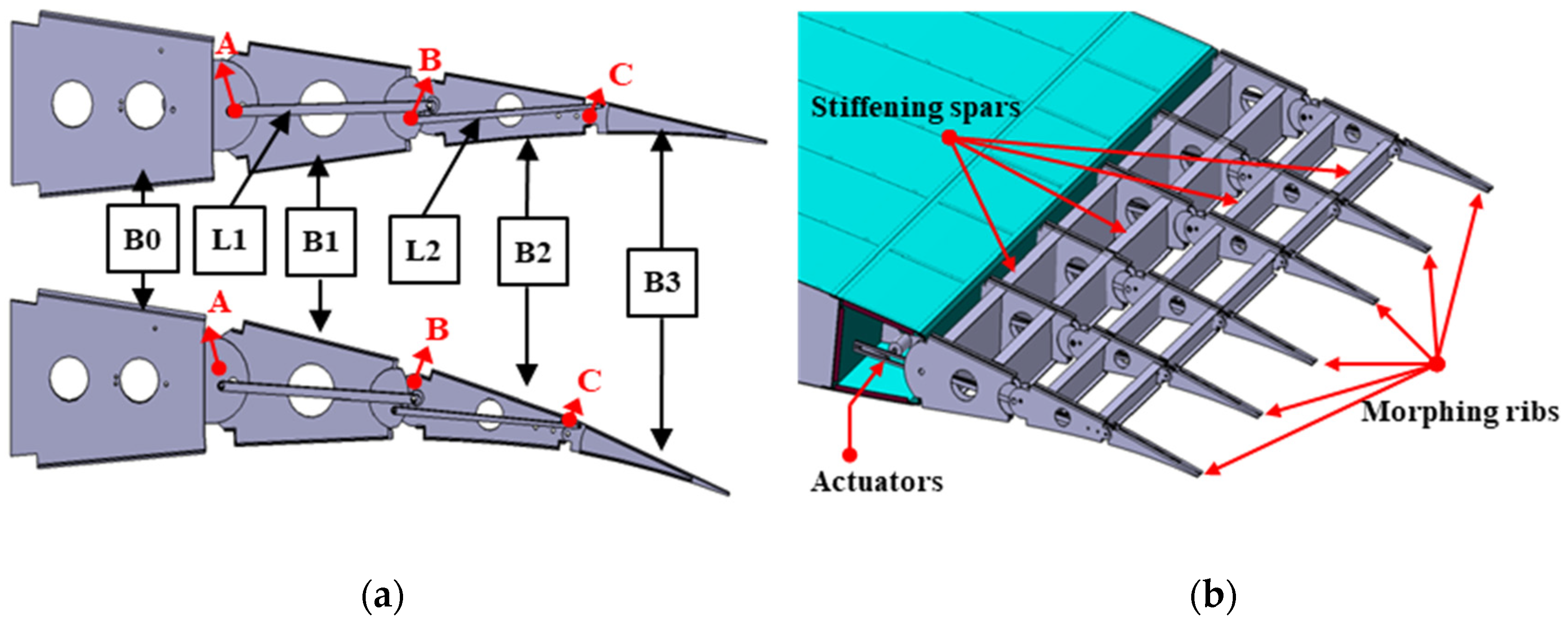

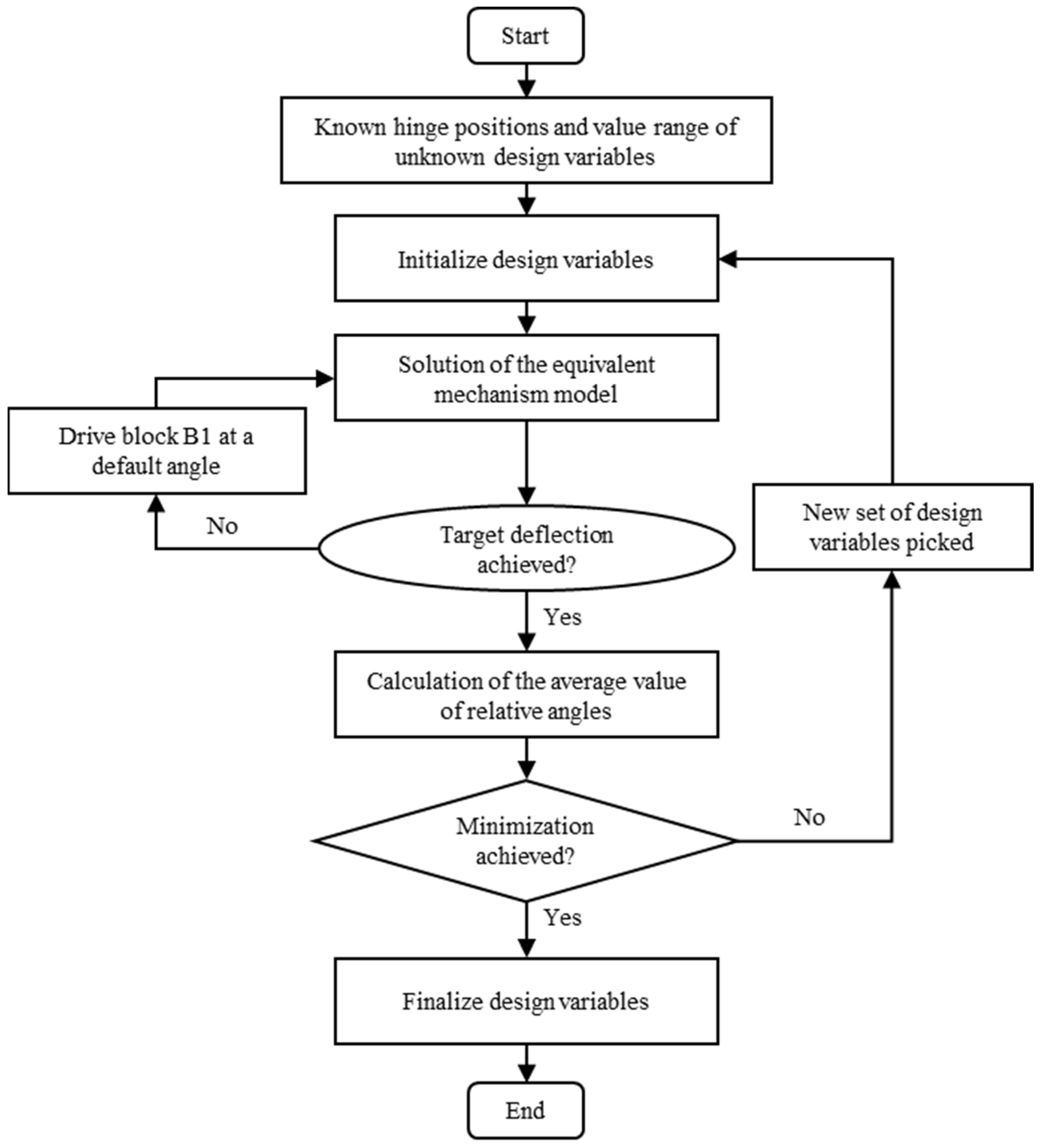

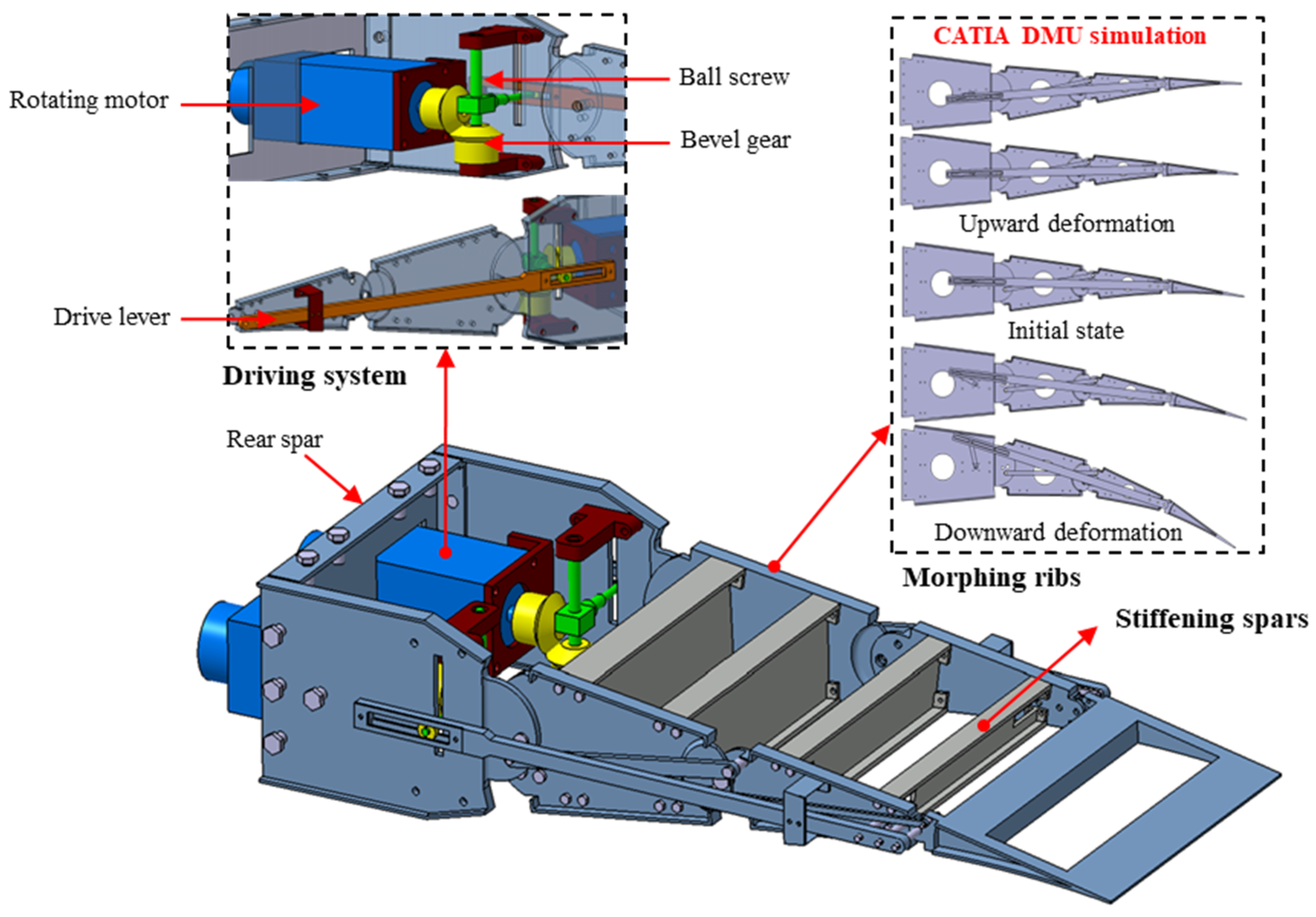

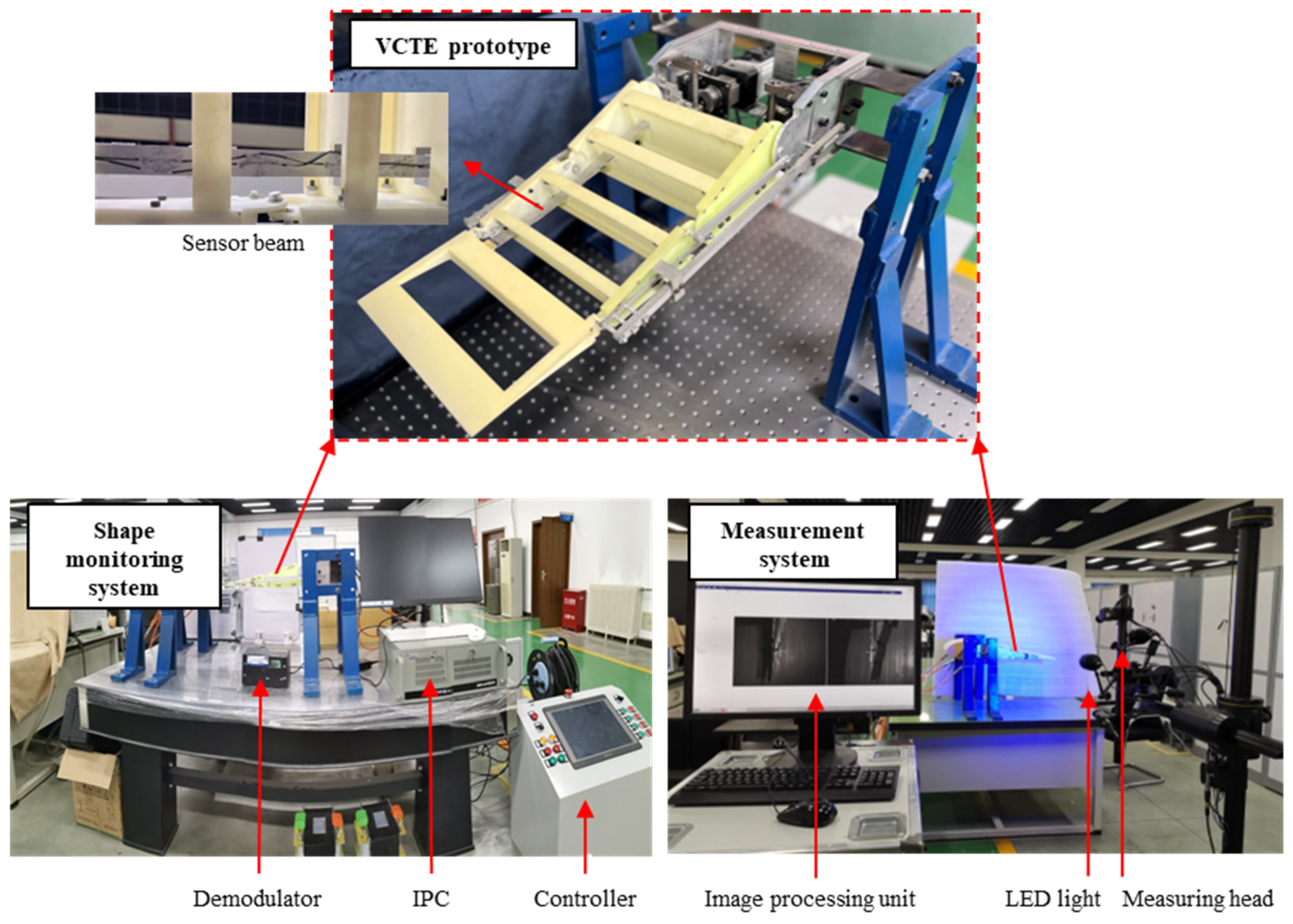
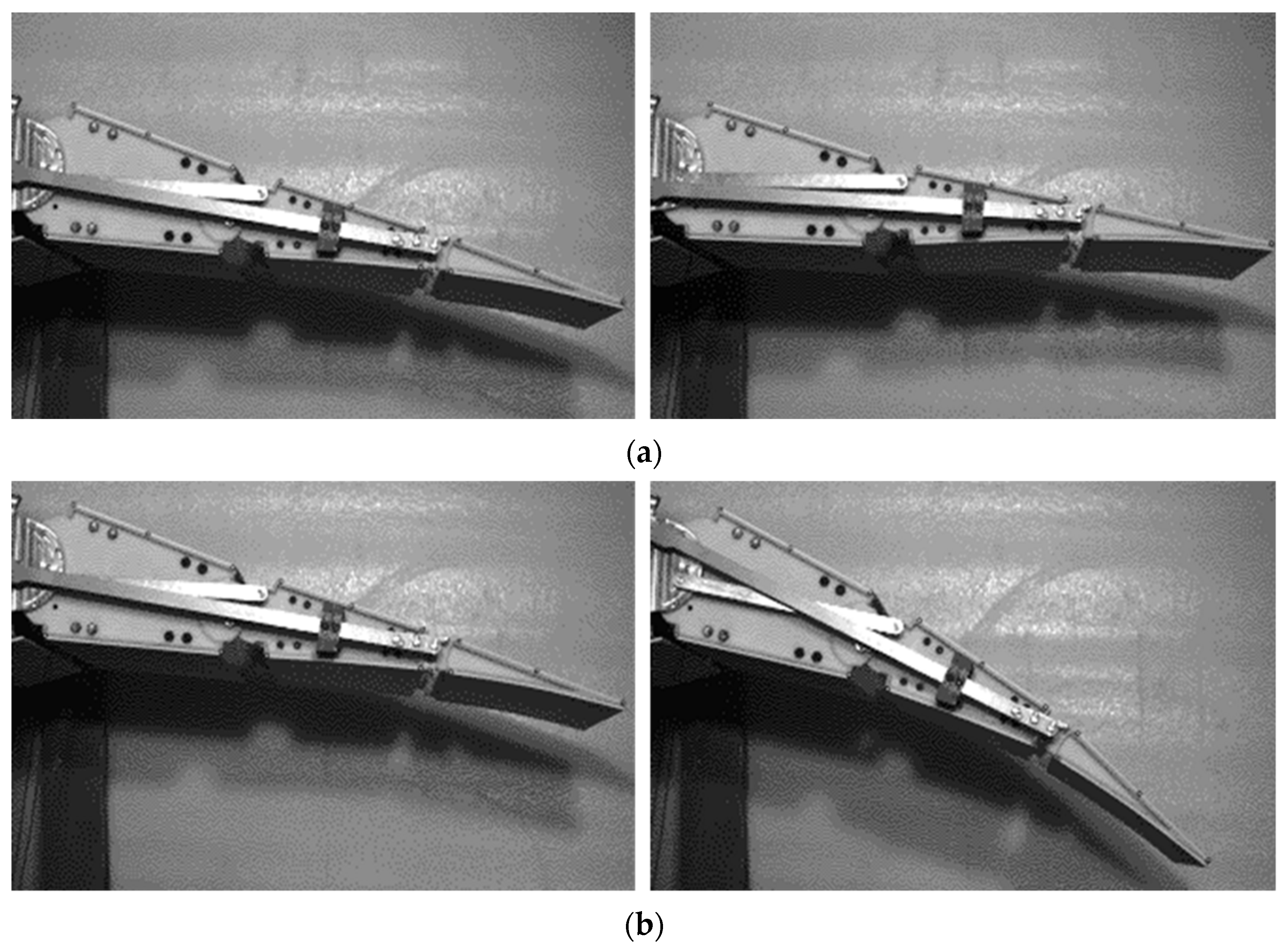
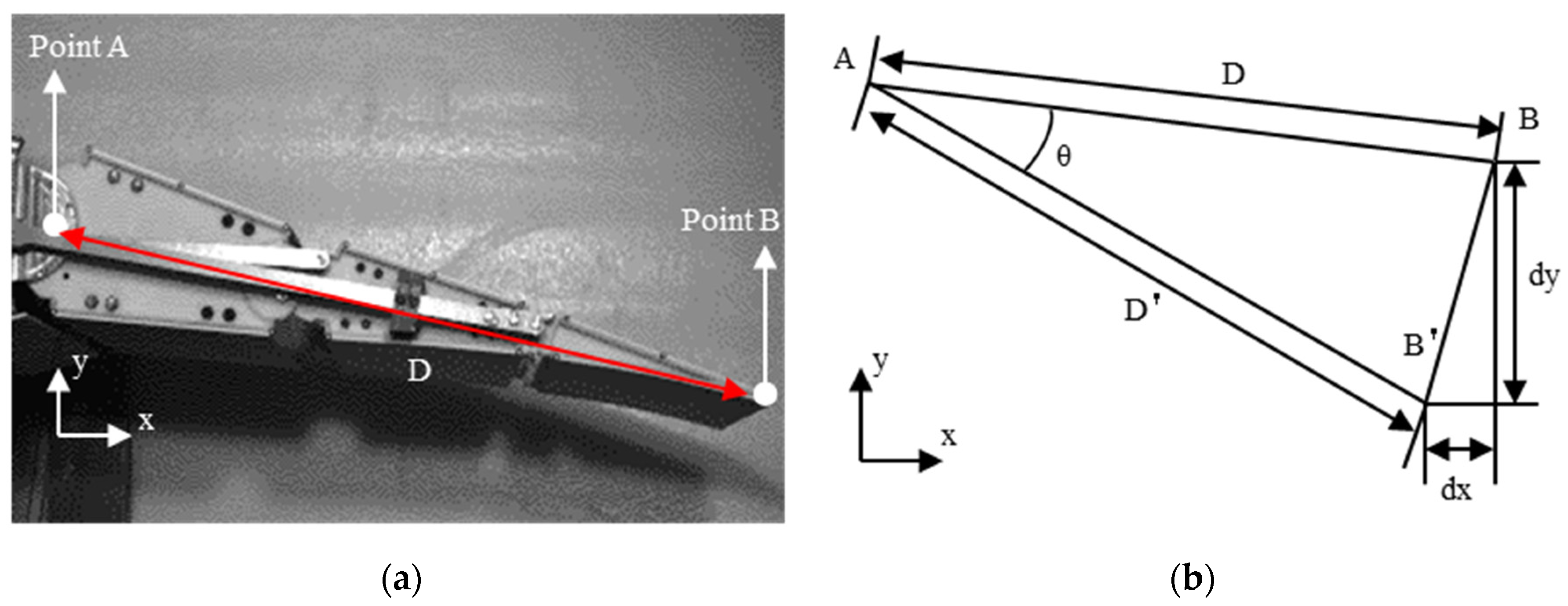

| Theoretical Deflection (°) | Measurements | Actual Deflection (°) | Error (%) | |||
|---|---|---|---|---|---|---|
| dx (mm) | dy (mm) | D′(mm) | D (mm) | |||
| −5 | 40.09 | −6.94 | 431.91 | 431.98 | −5.39 | 7.8 |
| 39.76 | −6.90 | 431.91 | −5.35 | 7.0 | ||
| 15 | −104.70 | 42.13 | 428.54 | 15.07 | 0.5 | |
| −105.00 | 42.28 | 428.55 | 15.11 | 0.7 | ||
Disclaimer/Publisher’s Note: The statements, opinions and data contained in all publications are solely those of the individual author(s) and contributor(s) and not of MDPI and/or the editor(s). MDPI and/or the editor(s) disclaim responsibility for any injury to people or property resulting from any ideas, methods, instructions or products referred to in the content. |
© 2023 by the authors. Licensee MDPI, Basel, Switzerland. This article is an open access article distributed under the terms and conditions of the Creative Commons Attribution (CC BY) license (https://creativecommons.org/licenses/by/4.0/).
Share and Cite
Shi, X.; Yang, Y.; Wang, Z.; Zhang, S.; Sun, X.; Feng, W. Design and Shape Monitoring of a Morphing Wing Trailing Edge. Aerospace 2023, 10, 127. https://doi.org/10.3390/aerospace10020127
Shi X, Yang Y, Wang Z, Zhang S, Sun X, Feng W. Design and Shape Monitoring of a Morphing Wing Trailing Edge. Aerospace. 2023; 10(2):127. https://doi.org/10.3390/aerospace10020127
Chicago/Turabian StyleShi, Xintong, Yu Yang, Zhigang Wang, Sheng Zhang, Xiasheng Sun, and Wei Feng. 2023. "Design and Shape Monitoring of a Morphing Wing Trailing Edge" Aerospace 10, no. 2: 127. https://doi.org/10.3390/aerospace10020127
APA StyleShi, X., Yang, Y., Wang, Z., Zhang, S., Sun, X., & Feng, W. (2023). Design and Shape Monitoring of a Morphing Wing Trailing Edge. Aerospace, 10(2), 127. https://doi.org/10.3390/aerospace10020127








